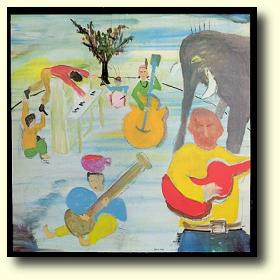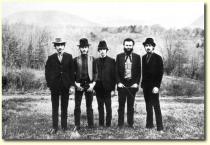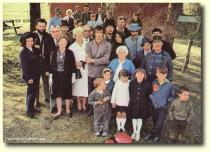
Big Pink in Retrospect
How Songs Learn: "The Weight" Hangs Tough at 35
by Leland Rucker
 The Album |
Back in those days, before FM radio formats became the norm, there was only Top 40 radio on the AM dial. I had become accustomed to hearing a song on the radio and, if I liked it, buying the 45-rpm single.
And I had begun venturing into 33 1/3 rpm albums, which, in the wake of Dylan's Highway 61 Revisited and the Beatles' Rubber Soul and Revolver, were becoming the medium of choice for rock "artists" and the music industry.
In effect, it was my first alt-record purchase. Music From Big Pink would become a landmark in my musical development. I took the plunge and plunked down my three bucks, placing my trust in the simple power of proximity -- by believing that the Band, whom Bob Dylan painted, would make music I would appreciate, too. It wouldn't be the last time.
Released in August 1968, Big Pink was an awkwardly packaged vinyl album. The Dylan work was a somewhat primitive and surreal cover painting of a gray elephant and six odd characters.
The six include a pianist sprawled across a greenish upright piano, with a second character holding him up by his feet so he can reach the keys. One looks like he's playing a sitar with a large espresso cup on his head. Another with a feather in a band around his head seems to be plucking a large bass guitar. The drummer, just a sketch, has a funny hat on, and the guitarist, the largest figure, straddles his reddish instrument under his right arm.
The back cover sports a snapshot of a rather ordinary, pink suburban house with a basement garage entrance. Giant, bold letters proclaim Music From Big Pink.
The cover folds out; on the left side of the inside fold are the names of the band members, a listing of songs and authors and the same photo of the pink house. Beneath it is a short paragraph explaining that the building is located "in the sun of Overlook Mountain in West Saugerties, New York" and that the music was "composed right there inside its walls."
Below that is a black-and-white photograph of five men standing in a forest. Dressed mostly in black with funny, old-timey hats, beards and mustaches, they looked older than they actually were at the time. (We would all find out later, they were pretty mature for their chronological ages.) And in the midst of psychedelia, the stark black and white stood out. For some reason, all their bodies are joined, except for a gap between Garth Hudson that separates Robbie Robertson from the rest of the group.
The entire right inside panel was a huge color photo of the same musicians standing, apparently, amidst their families, all sturdy pioneer stock, in front of a big red barn. The caption: Next of Kin.
Once you got to the inside jacket, you noticed that Dylan co-wrote some of the songs, and there were rumors that Dylan and these musicians who called themselves simply (or arrogantly, depending upon how you looked at it) the Band, had been making music together in the New York hill country.
Quite simply, the music on Big Pink was like nothing I had ever heard before -- or since, for that matter. It was familiar yet mysterious, startlingly unique. Perfect ensemble music. I felt I had heard bits and pieces of the songs somewhere before, but I couldn't put my finger on any of it.
Well, I could put my finger on "Long Black Veil," which I already knew from a Kingston Trio record. The Trio being my earliest musical obsession, the fact that the Band recorded this song only strengthened the trust and faith.
I was mesmerized by the three (or four, I couldn't tell) voices and especially the uncultivated harmonies careening every which way, jerking around melodies like I'd never heard before. They sounded like the guys in the picture looked, and their music was as weird and colorfully offbeat as the painting that graced the cover.
Big Pink retains its otherworldly qualities even in the transition to digital compact disc; 34 years after its release, it still sounds delightfully strange. Most popular music dates itself, betrayed either by its technology or its cultural environment. But Big Pink doesn't sound dated; it could have been recorded at the turn of the 20th century or the turn of the 21st. Of what other record could that be said?
Big Pink was one of the first records I replaced when compact discs came out. That first copy was mixed worse than the vinyl record -- you could hear the punch-ins on overdubs! Capitol released a proper CD mix a few years later, and a 21st-century repackaging effort includes most of the songs from the official Basement Tapes among other session outtakes that help place the final song selection in better context. What would it have sounded like with the raunchy "Yazoo Street Scandal," for instance. Or "Ferdinand the Imposter"?
There is a distinct American flavor to the music and lyrical imagery. Putting on side one, you are immediately confronted by a dirge anchored by a mournful organ that sounded like it had been sampled from a funeral after a Civil War battle. The subject matter of "Tears of Rage" floored me. Written by Bob Dylan and Richard Manuel, "Tears of Rage," an appeal from a father -- perhaps one of those Next of Kin folks on the inside cover -- to a daughter who had run off with the hippies. Hurt and confused, he begs her to return home: "Come to me now, you know, we're so alone, and life is brief." Nobody had ever written a song that took its cue from our parents' point of view.
I found out soon enough that the group was composed of four Canadians and one Arkansan, and that Robbie Robertson, Rick Danko, Garth Hudson, Richard Manuel and Levon Helm, respectively, had spent awhile backing up rockabilly lounge lizard Ronnie Hawkins before joining Dylan on tour in 1966 as the Hawks. Word was also circulating about some recordings known as The Basement Tapes because they were also came from that pink suburban house in upstate New York pictured on the back cover. Big Pink. Dylan. Basement tapes. A mythology was already settling in around this album.
To say I loved the album would be quite the understatement. It contains my all-time favorite Bob Dylan song, "I Shall Be Released," and Manuel's trembling, shimmering vocal makes it still my favorite cover rendition of a Bob Dylan song, too.
"Wheels on Fire," written by Dylan and Rick Danko, was another showcase for their idiosyncratic sound, and its impact was immediate when it appeared in a more psychedelicized version on 1969's Dr. Byrds and Mr. Hyde. "Chest Fever," an instrumental showcase featuring master-of-weird-sounds Garth Hudson, more than lives up to its flu-symptom title. "We Can Talk" took my heart away, those three voices ping-ponging all over the place, one actually screaming harmonies in breathtaking stereophonic cacophony. And though I was still a neophyte, the drug references didnít completely evade me.
"The Weight" ends side one. It has five verses, which the vocalists take turns singing and harmonizing in various combinations. The lyrics are a pastiche of incongruous, often funny images, ostensibly about a traveler who encounters a gaggle of comic-book characters.
I was studying for the Lutheran ministry at the time, and the first lines, "I pulled into Nazareth, I was feeling 'bout half past dead," sung by Levon Helm, the group's lone American, with its seeming biblical reference to where Jesus grew up, caught my ear immediately. The song's gentle loping pace, dragged by Helm's drowsy, deliberate drumming, the frayed harmonies and the incredibly catchy chorus quickly made it a personal favorite -- one of those songs which, to the dismay of my dormitory mates, I had to play hundreds of times before I could give it up.
Besides the Holy Land reference, there were several other loosely biblical personalities in the parable-like verses: Miss Moses, Carmen and the Devil are "walking side by side"; and Luke, who's "waitin' on the judgment day," asks the traveler to "keep Anna Lee company." Crazy Chester offers to fix the traveler's rack if he'll just take his dog, while Miss Fanny, who seems to have sent the bewildered traveler into this roots-music hallucination, is referenced in the oblique, sing-along chorus: "Take a load off Fanny (or were they saying off Annie?), take a load for free, take a load off Fanny, and ("and, and," "and," the ragged voices would chime in), "you put the load right on me."
The lyrics didn't make any literal sense, and the title puzzled me as well. Was it allegorical? Why does the load (the weight?) get put right on me? A metaphorical reference to guilt? Why wasn't it called "Take a Load Off Fanny" or "Take a Load Off?"
As it turns out, my translation of the song as some kind of New Testament allegory is contradicted completely by the facts of the writing of the song. Robertson chose Nazareth not because it was where Jesus grew up but because that was the town in Pennsylvania where his Martin guitar was built. He found it by looking inside the instrument. Duh.
The other characters were small-town denizens the band members ran across during their barnstorming-with-Hawkins days, Levon Helm writes in his autobiography, This Wheel's on Fire. "Luke was Jimmy Ray Paulman ... Anna Lee was Anna Lee Williams from Turkey Scratch. Crazy Chester was a guy we all knew from Fayetteville who came into town on Saturdays wearing a full set of cap guns on his hips and kinda walked around town to help keep the peace, if you follow me ... Fanny was a name that just seemed to fit the picture."
So much for the biblical overtones. I'm still not sure what it means. Robertson once said it was "about the impossibility of sainthood," a line that Helm quotes in his book and agrees with. (Perhaps the only thing upon which Robertson and Helm today are in accord.) But that explanation makes about as much sense to me as the discombobulated verses.
Along with Dylan's slightly earlier John Wesley Harding, Big Pink was a fresh dose of rootsy, folk-rock in the midst of the psychedelic era. Never a blockbuster hit, Big Pink reached only as high as No. 30 on the album charts during its seven-week run. According to the RIAA website, it only went gold (which means 500,000 copies) in 2001. "The Weight" only rose to No. 63 as a single.
Yet the album became as influential as the pink house became mythical. Eric Clapton, for instance, has always claimed that Big Pink changed his life. Together with the group's second album, The Band, it's a bookend of the best work the group would ever produce, together or apart, before or since.
"The Weight" has hung tough. Although the quintet wasn't shown performing it, "The Weight" was used during the stage-construction scene in the documentary Woodstock. It was featured in 1969's Easy Rider. The group, which creatively went into the crapper after its second album, reinvented the song twice. On the live album, Rock of Ages, "The Weight" retains its rustic ambience while allowing everybody to loosen up instrumentally.
Other artists took note of the song's ambiguity as well. In 1969, Aretha Franklin, aided by a funky all-star band, a mighty gospel chorus and appropriately swampy slide guitar courtesy Duane Allman, turned the song on its head, interpreting it as a wild, screaming, out-of-control, soul rave-up.
The group took Aretha's version to heart; the stuffy in-the-studio version that appears in The Last Waltz substitutes the Staple Singers for Aretha but manages to bring the gospel/R&B flavor Franklin unearthed to the forefront. Touched, perhaps, with a self-importance the song originally lacked, this recording sounds even more like the religious allegory I first heard.
A 2003 CD repackaging of the first New Riders of the Purple Sage album includes a version of "The Weight" as a added track. Recorded at the Fillmore West August 7, 1971, it includes a stoned John Dawson vocal while Jerry Garcia dropping atmospheric steel guitar bombs all around.
Years ago "The Weight" made its appearance in a commercial. I can't remember what it was for -- probably beer or something -- but it was used behind some footage of a sexy woman throwing her boyfriend's clothes out the door or into the dirt.
When The Band was released and the other members found that Robertson was credited with all the songs, a schism developed between the four and Robertson, from which they never quite recovered. Robertson exited with The Last Waltz and went into film soundtracks, acting and a couple of solo records.
The rest regrouped and enjoyed a few years of semi-success. Things started going badly, however. Richard Manuel, the group's most distinctive voice but least utilized member, hanged himself in 1986, and Helm, Hudson and Danko performed with Jim Weider, Randy Ciarlante and Richard Bell before Rick Danko died in 1999. Helm, who has survived throat cancer, performs today with the Barnburners, which includes his daughter as vocalist. Those wild, weird harmonies and voices have been forever stilled.
The last time I saw them, in early 1996 at the Fox Theatre, they were in good spirits and played an unpretentious show that featured some classics and a host of oldies that went all the way back to the days before Dylan came along. Their last two studio albums on Rhino, Jericho and Jubilation aren't bad, either.
Music From Big Pink came out in the months before I bought my first guitar, and I immediately started working on songs by the Band. Just getting through "The Weight" represented a quantum leap in my guitar development. "The Weight" requires you to switch to a barre chord (a more difficult chord in which you use your index finger to hold down all six strings and make the rest of the chord with your other three fingers) at the beginning of each verse. I can still remember the elation I felt the first time I was able to navigate the monster fingering change from A to C#m and actually be able to continue to the next chord. Wow.
It is also a perfect song for wonderfully ragged group participation. The chorus is especially fun, since it includes a full-measure pause just before the last phrase, which made it easy for even the musically challenged to join in for the kicker: "you put the load RIGHT ON ME." It's like learning "Brother John" or "Row, Row, Row Your Boat."
A recent conversation with a couple of younger friends ended up with me playing them the song. They had never heard of the group, but James smiled.
"We used to sing that at camp."
Turns out that at his kids' camp, somewhere near D.C. in the mid-1990s, just before dinner each day, James and his friends would sing together. Lyric sheets would be passed out, and everyone would join the counselors, some of whom also played guitars.
He couldn't remember any of the other songs they sang before their supper, but he remembered "The Weight." It was a pretty hip camp. Here we were singing "Cumbaya" when I was at camp; today they're singing "The Weight." We've come a long way.
Yet it seems so right, doesn't it? Can't you just see the teen-agers smiling at the funny words, wondering about Miss Fanny, laughing along with Crazy Chester and waiting for that dramatic pause just before crashing into "you put the load RIGHT ON ME?"
Watching "The Weight" stumble through American culture for almost 35 years, from its pink-house inception to baby-boom icon, soul rave-up, beer commercial and camp song reassures me that one of these days I'll figure out what it means.
Leland Rucker can be reached at: lerucker@comcast.net
Article copied from Dark Endeavors.
Reprinted with permission from the author.
The text is copyright © Leland Rucker 2003.


